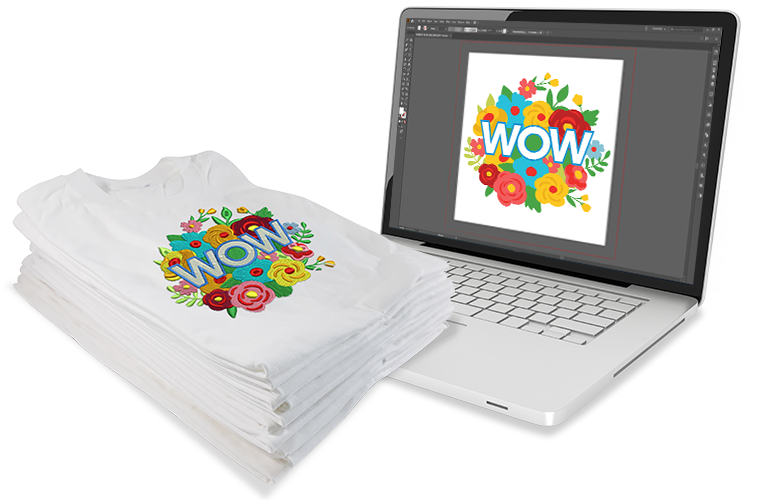Explore Different Types of Embroidery Digitizing Techniques
Embroidery digitizing has progressed significantly over the years, using a myriad of techniques to bring layouts to life in the electronic world. The world prolongs to a lot more advanced methods like photorealistic needlework digitizing and the fascinating realm of 3D needlework digitizing.
Typical Hand Embroidery Digitizing
Standard hand needlework digitizing involves the process of converting intricate hand-stitched layouts into digital formats for device needlework. This strategy needs knowledgeable craftsmens to carefully evaluate the handcrafted style and after that use specialized software to recreate it in a digital style. Each stitch, shade, and information needs to be meticulously equated to guarantee that the essence of the original hand embroidery is protected in the electronic variation.
Among the vital challenges of traditional hand embroidery digitizing is recording the complexities and subtleties of the handmade style. Digitizing for Embroidery. Artisans should have a deep understanding of different embroidery techniques, such as satin stitch, chain stitch, and French knots, to properly replicate these methods in the digital realm. In addition, they require to have a keen eye for detail to guarantee that the electronic design maintains the very same level of virtuosity and craftsmanship as the original hand-stitched item
Punching Method
To seamlessly change from standard hand embroidery digitizing to the boxing method, artisans must now focus on converting the elaborate digital layouts into guidelines that needlework makers can interpret. The boxing strategy includes utilizing specialized software application to create digital documents which contain commands for the embroidery maker to comply with. This procedure calls for a deep understanding of not simply the design itself yet also the abilities and limitations of the embroidery maker.

Auto-Digitizing Software Programs
Embroidery digitizing has been transformed by the arrival of auto-digitizing software program programs, providing craftsmens with innovative devices to transform digital layouts into needlework device instructions successfully. Auto-digitizing software application make use of algorithms to analyze digital pictures or vector data and generate embroidery designs automatically. These programs enable fast and precise conversion of elaborate styles right into stitch patterns, conserving effort and time for embroiderers.
One of the essential advantages of auto-digitizing software application is its straightforward user interface, making it available to both novices and experienced digitizers. These programs often consist of functions such as stitch modifying tools, thread shade matching, and the capability to preview the final stitched layout. In addition, auto-digitizing software application can manage complex styles with several colors and complex information, creating high-quality embroidery files suitable for various apparel and textile jobs.
While auto-digitizing software application supplies convenience and performance, it is essential for customers to recognize the limitations of automated digitizing. Fine-tuning and hand-operated adjustments may still be needed to achieve the wanted needlework quality, specifically when taking care of detailed or unique designs. By leveraging the capacities of auto-digitizing software alongside manual digitizing strategies, craftsmens can improve their needlework digitizing process and create sensational embroidered pieces.
Photorealistic Embroidery Digitizing
Utilizing sophisticated electronic imaging methods, attaining photorealistic lead to needlework digitizing has actually become a sought-after skill amongst modern artisans. This strategy involves converting high-resolution photos into complex stitch go to this site patterns that closely resemble the initial style, causing needlework pieces that exhibit natural detail and depth.
To achieve photorealistic embroidery digitizing, craftsmens have to possess a keen eye for detail and a detailed understanding of how various stitch types and thickness can affect the final outcome. By very carefully drawing up each shade and color in the photo, embroiderers can create an electronic documents that guides the needlework machine to replicate the nuances of the original image accurately.
Photorealistic needlework digitizing is particularly popular in producing custom styles for apparel, home decoration, and art items where capturing the significance of a photo or artwork is essential. This method enables artisans to transform memories, landscapes, pictures, and intricate art work right into stunning embroidered masterpieces that display a blend of standard craftsmanship and innovative modern technology.
3D Needlework Digitizing
With the development of electronic imaging techniques in achieving photorealistic lead to embroidery digitizing, the expedition of 'D Needlework Digitizing' uses a brand-new dimension to the intricacies of style duplication. 'D Embroidery Digitizing' describes the three-dimensional digitizing strategy that includes deepness and texture to embroidery styles, developing an extra practical and aesthetically appealing end continue reading this product. This strategy uses software that replicates the effect of light and shadow on the needlework design, improving its overall aesthetic impact.
One of the vital advantages of 'D Needlework Digitizing' is its capacity to make layouts look more realistic and vibrant. By adding deepness to the embroidery style, the final item appears more practical and captivating (Digitizing for Embroidery). Furthermore, this method permits even more innovative freedom in style implementation, enabling embroiderers to explore different appearances and impacts that were previously challenging to attain
Final Thought
